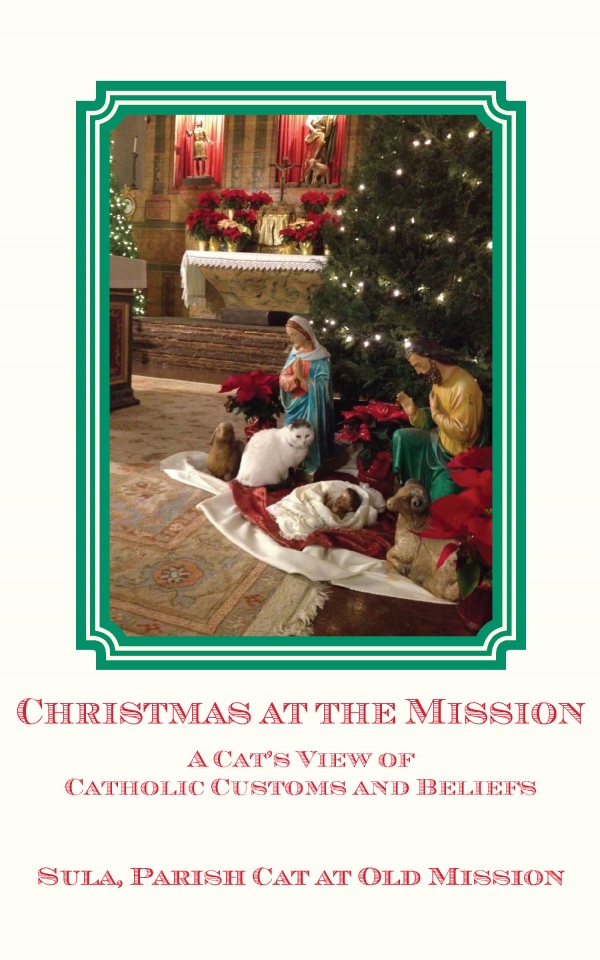Excerpt from Christmas at the Mission (Sula): "The Twelve Days of Christmas"
Sula, the parish cat at Old Mission San Juan Bautista, is quite a famous cat. Google her, and you will find lots of pictures and references. She has appeared as the lead article in Guideposts Magazine and in All Creatures Magazine -- and she has written six books of her own, including one in Spanish.
The excerpt below is from one of her earlier books, a beloved one that was illustrated by the late Zhenya Yanovich, a Russian artist of growing esteem.
The 12 Days of Christmas
The twelve days of Christmas refer to the period extending from Christmas to Epiphany. The song you just read and maybe even sang in your head is well known both to Catholics and to those not in the Church. It is a secular tribute to something sacred, but many people do not know the sacred part.
Do you know that there are three feasts during the 12 days of Christmas? They date from the fifth century and all focus on the incarnation of the Word of God (Christ) as the baby Jesus, human like us—well, like you; I am a cat. The three feasts are the Feast of St. Stephen, the Feast of St. John the Evangelist, and the Feast of the Holy Innocents.
The Feast of St. Stephen is first—on December 26. St. Stephen was one of the disciples. He was known for helping the poor. For that reason, we Catholics often give leftovers to the poor on December 26. (Giving them new stuff is pretty okay, too.) St. Stephen was also one of the first deacons. Did you know that we have had deacons for 20 centuries? Like all of Jesus’s disciples except John the Evangelist, St. Stephen was martyred; in fact, he was the first to be martyred. People who did not like Jesus put St. Stephen in a hole in the ground, covered him with dirt, and threw stones at him until he died. How painful! That means he died for his faith, like many people have over many centuries and like many people today in some parts of the world still do. Even though dying for one’s faith and being able to do that is something very special, I admit that I am very grateful that we Catholics can practice our faith in peace here in beautiful San Juan Bautista, which is sunny even at Christmas time, and not have to worry about people throwing stones at us, nailing us to trees, or even shooting us with guns. We live in a valley clearly blessed by God, and that blessing becomes even more meaningful during the 12 days of Christmas.
The Feast of S. John the Evangelist is next—on December 27. St. John was the only disciple not to be martyred, or so I am told. (I mean, I wasn’t there, after all, so I have to take some information as fact based on oral history, people telling people telling other people and, of course, stories written down, which are even better because the details do not change the way they do in oral histories.) John’s charism (gift from God) was the ability to write in ways that others understood. He was the one who told us about the Incarnation, writing that the Word became flesh and lived among people, i.e. us, well, you.
The third feast is the Feast of the Holy Innocents—on December 28. Remember how Herod told his soldiers to kill all baby boys under two years of age because he wanted to make sure he wiped out Jesus, who he feared was the Messiah. He was right about that last part; Jesus was the Messiah, but he was wrong about the first part. It is always wrong to kill, and these little baby boys were innocent of any wrongdoing. That is why we call them the Holy Innocents. They were the very first to die for Jesus.
One interesting thing that is not often talked about is that during these 12 days, around the first of January, is the time when the baby Jesus was circumcised. It seems like a very important thing, so maybe people ought to talk about it more. If God, in all His great power, became like a baby and submitted Himself to the Jewish law that required babies to be circumcised, what does that tell us today about obedience to the law of God? Many consider Jesus to be a great revolutionary because He totally changed much of what we think and do when it comes to our relationship to God, yet He was no rebel. He followed the traditions, customs, and laws of Judaism, just like the people of my parish follow the traditions, customs, and laws of Catholicism today. The message of Christ, though, strayed far from traditional thinking. Just think about it: God became a baby; Jesus taught us that the poor and lowly, not the rich, are the first in His kingdom, that political importance does not matter but love of God does. Our Catholic traditions look a lot different from run-of-the-mill human traditions, don’t they? I like that! It makes me, a lowly cat, feel very important. I thank God every morning, when I talk to St. Francis in the Mission garden, for considering me special enough to allow me the task of ministering to His people in our parish. That is a Christmas gift that lasts all year.
The 12 days of Christmas end on the epiphany. That is when the Wise Men (or Magi) bring the gifts to baby Jesus, but I will tell you about that later in this book.
-----
Read more of Sula's Christmas stories in Chrristmas at the Mission.

Read more blogposts about Sula, her life at the mission, her job at the gift shop, and her books.
Read about Sula online.





Comments
Post a Comment